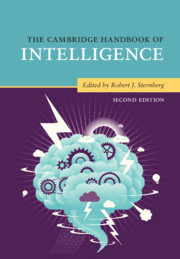Book contents
- The Cambridge Handbook of Intelligence
- The Cambridge Handbook of Intelligence
- Copyright page
- Dedication
- Contents
- Figures
- Tables
- Contributors
- Preface
- Part I Intelligence and Its Measurement
- Part II Development of Intelligence
- Part III Intelligence and Group Differences
- Part IV Biology of Intelligence
- Part V Intelligence and Information Processing
- 20 Basic Processes of Intelligence
- 21 Working Memory and Intelligence
- 22 Intelligence and Reasoning
- 23 Problem-Solving and Intelligence
- 24 Intelligence and Decision-Making
- 25 Artificial Intelligence
- 26 Intelligence and Video Games
- Part VI Kinds of Intelligence
- Part VII Intelligence and Its Role in Society
- Part VIII Intelligence and Allied Constructs
- Part IX Folk Conceptions of Intelligence
- Part X Conclusion
- Author Index
- Subject Index
- References
25 - Artificial Intelligence
from Part V - Intelligence and Information Processing
Published online by Cambridge University Press: 13 December 2019
- The Cambridge Handbook of Intelligence
- The Cambridge Handbook of Intelligence
- Copyright page
- Dedication
- Contents
- Figures
- Tables
- Contributors
- Preface
- Part I Intelligence and Its Measurement
- Part II Development of Intelligence
- Part III Intelligence and Group Differences
- Part IV Biology of Intelligence
- Part V Intelligence and Information Processing
- 20 Basic Processes of Intelligence
- 21 Working Memory and Intelligence
- 22 Intelligence and Reasoning
- 23 Problem-Solving and Intelligence
- 24 Intelligence and Decision-Making
- 25 Artificial Intelligence
- 26 Intelligence and Video Games
- Part VI Kinds of Intelligence
- Part VII Intelligence and Its Role in Society
- Part VIII Intelligence and Allied Constructs
- Part IX Folk Conceptions of Intelligence
- Part X Conclusion
- Author Index
- Subject Index
- References
Summary
Artificial intelligence (AI) is a scientific discipline that seeks to understand intelligence through the design and construction of intelligent machines. AI and cognitive science have a strong two-way relationship: Cognitive psychology often has inspired AI theories, and AI research has led to new theories of cognition that have been tested through psychological experimentation. While AI theories of cognition often are under-constrained, cognitive theories of AI tend to be over-constrained. Nevertheless, AI is useful for cognitive psychologists both as a source of new ideas and insights, and an experimental testbed. In this chapter, we describe some of the basic concepts and methods of AI by taking robot navigation in a city as an illustrative example. We also briefly discuss the history of AI, methods for assessing progress in AI, and some of AI’s potential impacts on society.
Keywords
- Type
- Chapter
- Information
- The Cambridge Handbook of Intelligence , pp. 602 - 625Publisher: Cambridge University PressPrint publication year: 2020
References
- 7
- Cited by

